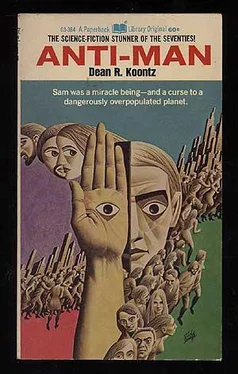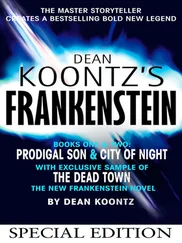Dean Koontz - Anti-Man
Здесь есть возможность читать онлайн «Dean Koontz - Anti-Man» весь текст электронной книги совершенно бесплатно (целиком полную версию без сокращений). В некоторых случаях можно слушать аудио, скачать через торрент в формате fb2 и присутствует краткое содержание. Год выпуска: 1970, Издательство: Paperback Library, Жанр: Ужасы и Мистика, на английском языке. Описание произведения, (предисловие) а так же отзывы посетителей доступны на портале библиотеки ЛибКат.
- Название:Anti-Man
- Автор:
- Издательство:Paperback Library
- Жанр:
- Год:1970
- ISBN:нет данных
- Рейтинг книги:5 / 5. Голосов: 1
-
Избранное:Добавить в избранное
- Отзывы:
-
Ваша оценка:
- 100
- 1
- 2
- 3
- 4
- 5
Anti-Man: краткое содержание, описание и аннотация
Предлагаем к чтению аннотацию, описание, краткое содержание или предисловие (зависит от того, что написал сам автор книги «Anti-Man»). Если вы не нашли необходимую информацию о книге — напишите в комментариях, мы постараемся отыскать её.
Anti-Man — читать онлайн бесплатно полную книгу (весь текст) целиком
Ниже представлен текст книги, разбитый по страницам. Система сохранения места последней прочитанной страницы, позволяет с удобством читать онлайн бесплатно книгу «Anti-Man», без необходимости каждый раз заново искать на чём Вы остановились. Поставьте закладку, и сможете в любой момент перейти на страницу, на которой закончили чтение.
Интервал:
Закладка:
We got out of the elevator and stepped into a tunnel-like corridor lighted by inset blue fluorescents, spotlessly clean, decorated in blue and white tile. Every so often, the continuity of the floor-tile pattern would be broken by large letters-WA-formed out of green tile and bent to form a globe. We walked perhaps a block until we came to a widening of the passage. Here, a man sat at a broad desk, surrounded by panels of electronic instruments and a huge board with fifty television screens off to his right. Each of the screens was no more than three inches by three inches, and each had a different picture on it, though the details of the various scenes were almost too small to decipher. We stopped before this desk and waited.
The man at the desk was pudgy and had a second chin that puffed out farther than his first. His arms were like large, ready-to-burst sausages as they swept over the controls on the desk. Oddly, his head was luxuriant with black-gray hair that was obviously the result of Volper Stimulants to correct baldness. If he did not mind being heavy, why did he mind being bald? He did not look up at us immediately, but flipped another switch and turned to his right in his swivel chair. One of the three-inch screens on the big board moved out from the wall on an extensor arm, glided four feet, right up to his face, and stopped. The man examined the scene carefully. I could see what it was now: a cell. Each of those screens represented a cell in a maximum security prison, and the men in those cells were almost constantly being observed. When the clerk was satisfied with the behavior of the prisoner he was watching, he directed the extensor arm back, and the screen settled into its niche in the board. At last, he turned to us and said, "Yes?"
"Kennelmen," the armed guard on my right said.
The jailer's eyebrows raised an inch.
"You want us to stay with him?" the guard asked.
"No," the jailer said. "Just wait until I get my Clancy hooked up to him. He won't bother me then."
I had heard about the Clancy used by WA police, though I had never had occasion to see one in use — let alone being attached to one. The Clancy is a robot, only as large as a beachball, spherical. Extending from apposite halves of its ball-shaped body are two strong, steel-nickle cable tentacles that terminate in handcuffs of a peculiar design. The cuffs are really heavier loops of the cable with a structured elasticity that allows them to conform to whatever wrist-size they are expected to encompass. Yet, the Clancy is more than a sophisticated set of cuffs. It floats before the prisoner on its anti-grav plate, directly out from his chest, three or four feet away (they had the same problem with anti-grav plates as they did with Kesey's magnetic sleds: the plates can only be developed to a limited size, eighteen inches by eighteen inches. From then on, the field they generate is so erratic as to be totally unsafe. But the Clancy is the right size and can make good use of the anti-grav mechanisms). The cop can tell the Clancy where to take the prisoner, and the Clancy obeys, dragging its keep behind. If the prisoner gets unruly, the Clancy has a very efficient method of settling him down. The cuffs are contracted around the wrists, tighter and tighter, until the pain convinces the scoundrel that he really doesn't mind being arrested. If that doesn't work, the cables can transmit a stunning shock from the Clancy's battery. In short, the Clancy is the policeman's best friend.
Why a name like Clancy? Well, it was this Irish cop that originally came up with the idea of using the grav-plates for such a purpose, patented the idea, and named it after himself. Probably the only cop in the city's history to immortalize himself.
The jailer worked over his switches and dials, then turned to the wall behind him. A moment later, a section of the wall slid up, the blue Clancy sphere floated out, its cable tentacles dangling to either side like thick lanks of greasy hair. The jailer directed it, then leaned back and watched as it set about doing its duty.
I tensed as the machine came toward me, moving silently, evenly, its single sight receptor nodule (set at the top and able to scan in all directions) shimmering a pretty green. The tentacles snaked out, the loop of cuffs opened at the end so that the cuff looked like two fingers or talons. The talons slipped around my right hand and tightened, even though I tried to pull away. I offered my left hand without battle. Still following the jailer's instructions, the Clancy led me to the sliding door in the wall and opened it by emitting an audible beep. Beyond, the tunnel-like corridor continued. With the Clancy dragging me along, we went through the door into the WA prison. The door slid shut behind.
Once, I tried to work against the machine. I set my heels and refused to move. It tugged at me, harder and harder, then jerked so suddenly that I tipped forward, staggered, could not regain my balance, and went down on my shoulder on the hard floor. The Clancy floated above, tilted a bit so that its sight nodule could scan me. Its tentacles were stretched to the limit. It tried to pull me up, but could not manage the task. Then I felt the tightening of the cuffs. My hands began to grow numb and took on a bluish coloration. When it grew painful enough, I gave up this childishness and stood. I cooperated from then on.
It led me down the tunnel a good way, then through a second door; this, a dilating circle that cycled open at another electronic signal and admitted us to the chamber beyond. This was the prison proper, the area of the cells. Along each wall were dilating doors of heavy metal, each about twenty feet apart. The Clancy led me to the sixth door on the right, dilated it with another beep, and took me inside.
The cell was spacious, well-lighted, and comfortably furnished. Indeed, I was a little surprised at the lavish-ness of it. There was a network comscreen for news and entertainment, a chute from the library where stat copies of articles or reprints of novel tapes would be delivered on request. The toilet was enclosed and at the far right comer. When the standard melodrama relates a picture of the average modern prison as a hell-hole full of rats, lice, and sadistic jailers, it is giving the viewer a representation of the standard prison of the Fifties, maybe even through the Seventies and early Eighties. But prison reforms have been drastic in the last couple of decades, and prisoners are no longer treated as animals.
The Clancy led me to the cot, backed me into it until I understood that I was to sit. I plopped backward, and was pleased with the springiness, the softness of what had looked like only a mediocre bed. The cuffs opened, fell away to hang at the Clancy's side. It floated back to the dilated door, went through, letting the portal spiral shut in its wake.
Seconds later, the central mail delivery chute next to the library receptacle made a buzzing sound, and something dropped into the tray beneath it. I got up and went to the wall, picked the small, blue square of plastic out of the tray. It was a penitentiary credit card with my name and number. The jailer had submitted my name to the central city banks and had discovered, within a minute or so, that I was a good credit risk and had plenty of cards already. Upon discovering this, he had punched the prison computer to issue me a card for my stay in jail. With it, I could order anything over the phone (which was set next to the wall of the bathroom) and have it delivered by mail. The bill would go to my wife (if I had one, which I did not), to my lawyer (if a professional firm handled all my credit payments, which Alton-Boskone and Fenner did for me), or to my bank, where, the moment I had been checked into my cell, my accounts had been frozen by government order. In the end, the prisoner paid, but at least he lived well enough during his confinement.
Читать дальшеИнтервал:
Закладка:
Похожие книги на «Anti-Man»
Представляем Вашему вниманию похожие книги на «Anti-Man» списком для выбора. Мы отобрали схожую по названию и смыслу литературу в надежде предоставить читателям больше вариантов отыскать новые, интересные, ещё непрочитанные произведения.
Обсуждение, отзывы о книге «Anti-Man» и просто собственные мнения читателей. Оставьте ваши комментарии, напишите, что Вы думаете о произведении, его смысле или главных героях. Укажите что конкретно понравилось, а что нет, и почему Вы так считаете.











